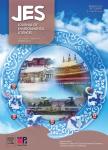TOF–SIMS surface analysis of chemical components of size–fractioned urban aerosols in a typical heavy air pollution event in Beijing
TOF–SIMS surface analysis of chemical components of size–fractioned urban aerosols in a typical heavy air pollution event in Beijing作者机构:College of Resource and Environmental Engineering Guizhou University Guiyang 550025 China State Key Laboratory of Environmental Criteria and Risk Assessment Chinese Research Academy of Environmental Sciences Beijing 100012 China Collaborative Innovation Center on Atmospheric Environment and Equipment Technology Nanjing University of Information Science andTechnology Nanjing 210044 China SAE Technology Development (Dongguan) Co. Ltd. Guangdong 523087 China Environment Research Institute Shandong University Jinan 250100 China College of Earth SciencesJilin University Changchun 130061 China Institute of Environment Science Shanxi University Shanxi 030001 China Core Tech Integrated (Beijing) Pty. Ltd. Beijing 100086 China
出 版 物:《Journal of Environmental Sciences》 (环境科学学报(英文版))
年 卷 期:2018年第30卷第7期
页 面:61-76页
核心收录:
学科分类:07[理学] 070602[理学-大气物理学与大气环境] 0706[理学-大气科学]
基 金:supported by the National Natural Science Foundation of China(Nos.41175111 and 21177078) the Strategic Pilot Science and Technology Project of the Chinese Academy of Sciences(Class B)(No.XDB05010200) the National Natural Science Foundation of China(No.41265008) Key Discipline Construction Project,Guizhou(No.ZDXK11)
主 题:Atmospheric aerosol particles Air pollution event Surface chemical composition Influence factor Static Time-of-flight secondary ion mass spectrometry Beijing
摘 要:Size–fractioned atmospheric aerosol particles were collected during a typical heavy air pollution event in Beijing. The organic and inorganic components on the surfaces of the samples were analyzed using time–of–flight secondary ion mass spectrometry(TOF–SIMS).The variation characteristics of the surface chemical composition and influencing factors were studied, and the possible sources of these chemical compositions were identified through principal component analysis. The results showed that inorganic components such as crustal elements and sulfate, and organic components such as aliphatic hydrocarbons and oxygen–containing organic groups were present. Some surface components, such as polycyclic aromatic hydrocarbons, heavy metals and fluorides may exert adverse effects on human health. The species and relative percentages of the chemical components varied with particle size, diurnal and pollution progress. During a heavy pollution event, the species and relative percentages of secondary components such as oxygen–containing organic groups and sulfurous compounds increased, indicating that particles aged during this event. The surface chemical composition of the aerosol particles was affected mainly by emissions from coal combustion and motor vehicles. In addition, air pollution, meteorological factors, and air mass transport also exerted a significant effect on the surface chemical composition of aerosol particles.



